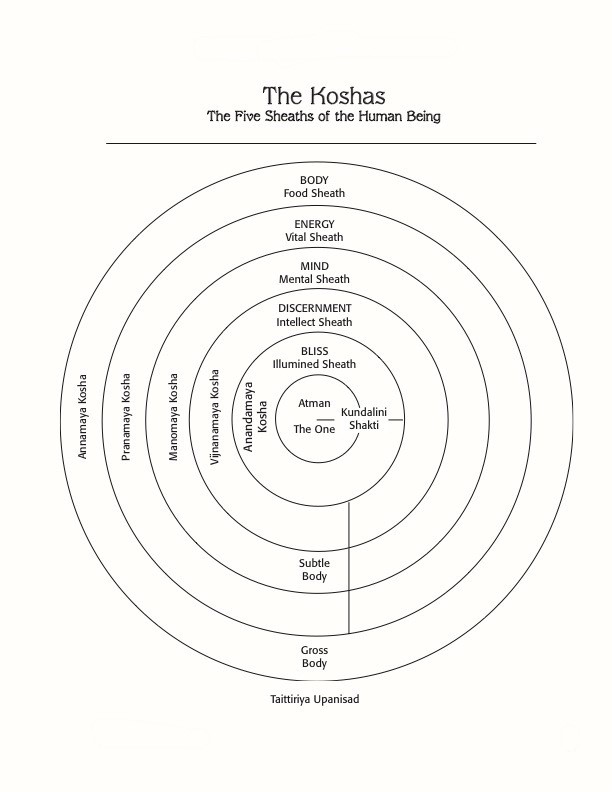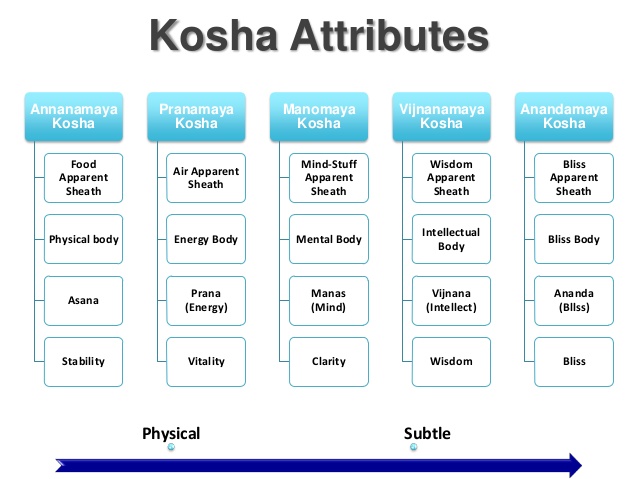Koshas – Yogic Sheaths of Our Being

Over thousands of years, yogis used various practices of Yoga to experientially understand the way we are, and function, vis a vis this whole universe. One of the important basic concepts which helps us understand this is that of Koshas. The Yoga path of Self-realization is one of progressively moving inward, through each of those five levels, so as to experience the purity at the eternal center of consciousness, while at the same time allowing that purity to animate through our individuality. These five levels are called koshas, which literally means sheaths. Yoga defines our being as having five layers or sheaths, each one contained within the other, like peels/ layers of an onion, or Russian Dolls. These sheaths cover every aspect of our being, from the grossest to the subtlest.
Yoga tells us that you are not just the body you perceive with the eyes, nor are you just blood, bones, marrow, muscles, nerves and the different organs that keep you alive. You are much more than that. What you see of yourself with the eye is sustained by what you cannot see; if the unseen part of you ceased to exist, the seen part of you would wither and die. This seen and unseen part of you is composed of the five koshas. The aim of all the practices of yoga, without exception, is to energize and awaken these koshas until ultimately you experience awakening in vigyanamaya kosha. That alone is the purpose of yoga. When we practice yoga – whether it’s asana, pranayama, meditation, mantra, or even karma yoga – we are having an impact on one or more of these layers of the body. The practices of yoga work to release blockages in the many layers of the body. Understanding these basic concepts helps us to figure out why sometimes we feel stuck in our practice, or feel that we are not making any progress.
Consciousness
Consciousness is the ultimate reality out of which mind and matter proceed. It is the state or quality of awareness, or, of being aware of an external object or something within oneself. It has been defined as sentience, awareness, subjectivity, the ability to experience or to feel, wakefulness, having a sense of selfhood, and the executive control system of the mind. Many philosophers believe that there is a broadly shared underlying intuition about what consciousness is.
At one time consciousness was viewed with skepticism by many scientists, but in recent years it has become a significant topic of research in psychology, neuropsychology and neuroscience. The primary focus is on understanding and determining the neural and psychological correlates of consciousness. In medicine, consciousness is assessed by observing a patient’s arousal and responsiveness, and can be seen as a continuum of states ranging from full alertness and comprehension, through disorientation, delirium, loss of meaningful communication, and finally loss of movement in response to painful stimuli.
In Yoga, individual consciousness is considered a partial expression of cosmic consciousness. Essentially, cosmic consciousness and individual consciousness are one; only subjectivity separates them. Consciousness exists at various levels from minerals to man. Of all existing organisms that express themselves through behaviour, the human organism is the most highly evolved. It is capable of self-expression and the realization of The Truth beyond the realm of sensory perception. With the help of memory, imagination, intuition and discrimination, the human organism can understand laws inherent in nature and use them for growth and development.
Expression of Consciousness
When consciousness desires expression as an organism, it needs tools to control and work with the physical body. In general, we have two major aspects:
- changeable, the feminine, and,
- unchangeable, the masculine.
This is illustrated by the Shiva and Shakti as a playing couple, representing the masculine and the feminine aspects respectively.

Shiva, the masculine, represents the divine lover, and, Shakti, the feminine, represents the energy and the beloved. She wants to play a game. She creates a world of her own and invites Shiva inside. Shiva says that he is never changing, so he cannot live in Shakti’s ever-changing world! Shakti suggests, “You can be the centre of everything, and the centre never changes, everything around it changes. You can stay in your eternal bliss in the centre, and around you, I will put a network of my shakti (power) which will be a conduit between you and the outside world. That way you will not have to do anything – you can remain never changing and I can remain ever changing and we can have fun!”
Shiva agrees and the game begins…!
Pancha-Koshas – The Five Sheaths
Taittiriya Upanishad says:
- Human beings consist of a material body made up from the food they eat. Those who care for this body are nourished by the universe itself.
- Inside this is another body made of life energy. It fills the physical body and takes its shape. Those who treat this vital force as divine experience excellent health and longevity because this energy is the source of physical life.
- Within the vital force is yet another body, this one made of thought energy. It fills the two denser bodies and has the same shape. Those who understand and control the mental body are no longer afflicted by fear.
- Deeper still lies another body comprised of intellect. It permeates the three denser bodies and takes up the same form. Those who establish their awareness here, free themselves from unhealthy thoughts and actions, and develop the self-control necessary to achieve their goals.
- Hidden inside it is yet a subtler body, composed of pure joy. It pervades the other bodies and shares the same shape. It is experienced as happiness, delight, equanimity and bliss.
In Yoga philosophy, the body, mind and spirit are understood as one continuum. Indian philosophers spoke about consciousness: the bodies as described above in Taittiriya Upanishad are known as koshas (sheaths). These five koshas are:
- Annamaya Kosha or Physical Sheath,
- Pranamaya Kosha or Energy Sheath,
- Manomaya Kosha or Mental Sheath,
- Vigyanamaya Kosha or Wisdom Sheath, and
- Anandamaya Kosha or Equanimity or Bliss
In some systems there is a sixth sheath, the hiranyagarbha kosha. According to Vedanta, the wise man should discriminate between atman (the self) and the koshas, which are non-self.
Expansion of Consciousness, the path of Self-realization in Yoga, is the one of progressively moving inward, through each of those layers, so as to experience the purity at the center of consciousness, while at the same time allowing that purity to animate through individuality.

Koshas and Shariras
These five koshas belong to or co-relate with three bodies that constitute your being. These Tri-Shareera or three bodies are:
- Physical Body or Gross Body or Sthula Shareera which has only one layer of Annamaya Kosha
- Astral Body or Linga Shareera or Sukshma Shareera. Subtle Body is Astral Body except a part of Pranic Sheath. Every living being has an astral body. This is connected to the physical body by a subtle thread along which vital energy flows. When this cord is cut, the astral body departs and the physical body dies. The astral body is composed of three layers:
- Layer one: Pranamaya Kosha or Pranic Sheath, much subtler than the food sheath, it is often spoken of as the etheric double. It is made up of 72,000 nadis, or astral tubes, through which prana, the vital energy, flows.
- Layer two: Manomaya Kosha or Mental Sheath, comprising the automatic mind, as well as the instinctive and subconscious regions. This is where we carry on the automatic functions of our daily lives; it is very jumpy by nature, as it is constantly bombarded by inputs from the five senses.
- Layer three: Vigyanamaya Kosha or Intellectual or Wisdom Sheath, the intellect controls and guides the automatic mind. Discrimination and decision making take place here and pass down to the grosser sheath.
- Causal Body or Karan Shareera which has only one layer of Anandamaya Kosha. This stores all of our karmas, samskaras and impressions of many, many incarnations is the one we encounter when we speak about awakening in vigyanamaya kosha.
The experiences of evolution through different ‘yonis’, pleasant and unpleasant, are stored in the vigyanamaya kosha. In order to step into the arena of spiritual ecstasy, you have to pass through this zone and face what is stored there eye to eye. You simply cannot avoid it, just as you cannot avoid your thoughts or your feelings and dreams. The practices of yoga can accelerate this process and accomplish this in a systematic and graded manner. It is only when the awakening occurs in vigyanamaya and that experience is stabilized, that the transcendental experiences of ecstasy and bliss related to anandamaya kosha arise in the consciousness.
In modern psychology, the causal body or karana sharira is known as the realm of the unconscious; it may also be termed as psyche’ of man. You cannot know what is stored there until there is awakening in vigyanamaya kosha. When you experience awakening in manomaya kosha, you are still within the realm of buddhi or intellect. Everything that you experience will be within the fold of logic and reason and thus there is a degree of control of the experiences and their outcome. It’s in vigyanamaya kosha that you go beyond the level of the mind.
Every day you have three types of experiences:
- The waking experience in which you experience through your senses and mind.
- Dream, in which you do not experience through the senses, but through your subconscious mind.
- Sleep, in which there is no knowledge of time and space, no knowledge about yourself or about anything in sleep, but when you get up in the morning, you know that you slept well the night before.
So every day, the individual self undergoes these three experiences alternately. Each experience relates to a particular field. Whenever your individual self goes to one particular field, realm, dimension or kosha, it has one experience, and as your individual self changes the kosha, it has another experience.
Koshas and Lokas
The complete Gayatri mantra tells us about the relation of koshas and lokas:
Om Bhur Om Bhuvah Om Swaha Om Mahah Om Janah Om Tapah Om Satyam ||
Om bhur bhuvah swaha Tat suvitur varenyam Bhargo devasya dhimahi Dhiyo yo nah prachodayat ||
OM, the primordial sound, resides in all elements of the universe. It permeates the earth (bhuh), water (bhuvah), fire (swaha), air (mahah), ether (janah), intelligence (tapah)
and consciousness (satyam). We invoke and meditate on the glory of that Being who has produced this universe, may He enlighten our minds.
Lokas are the planes of consciousness one experiences as the awareness gains ascent from annamaya to pranamaya to manomaya to vigyanamaya. The sapta or seven lokas, as given in the above mantra are:
- bhu – earth
- bhuvah – water
- swah – fire
- maha – air
- janah – ether
- tapah – intelligence/ intellect, and
- satyam – consciousness
While bhu, bhuvah and swah, the earthly, intermediate and divine planes, are related to annamaya, pranamaya and manomaya koshas, maha, the plane of siddhas, janah, the plane of rishis and munis, and tapah, the plane of liberated souls, relate to awakening, stabilization and illumination of vigyanamaya. Satymais the loka of ultimate bliss or consciousness.
Koshas – Yogis Sheaths of our Being
Annamaya Kosha or Physical Body
Pranamaya Kosha or Energy Body
Vigyanamaya Kosha or Intellectual or Wisdom Body
To delve deeper into this important topic in Yoga, please check different courses at SAVY.
President and Director of Teaching


You must be logged in to post a comment.